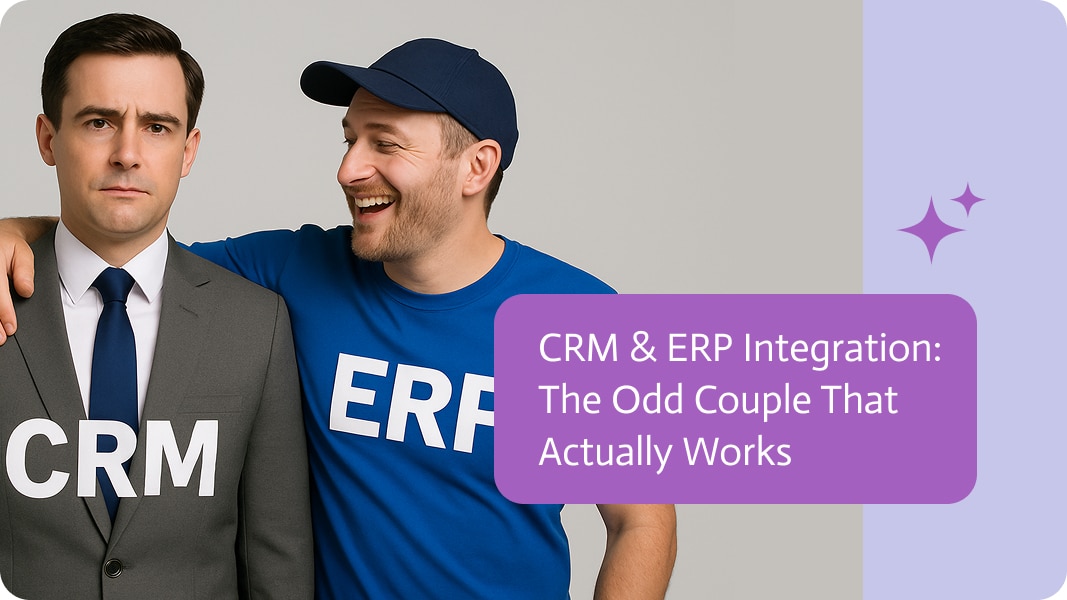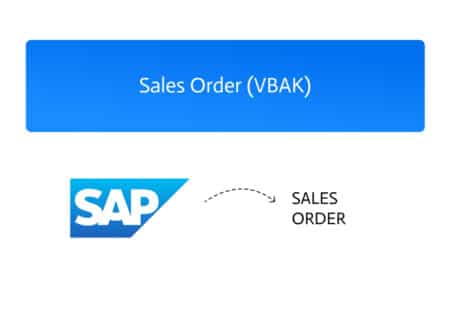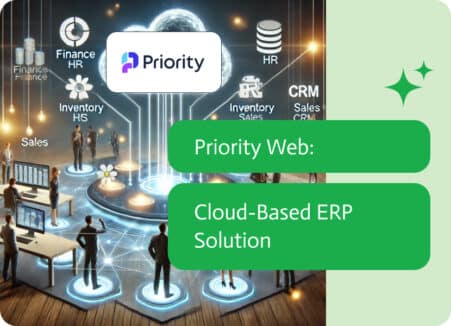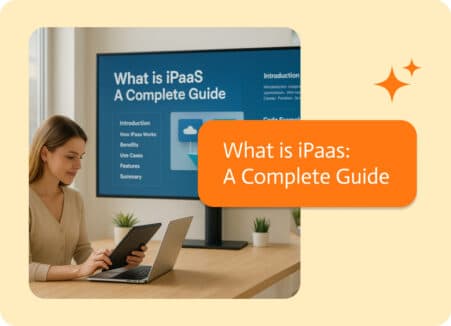

CRM and ERP Integration: The Odd Couple That Actually Works
The process of linking your Customer Relationship Management (CRM) system with your Enterprise Resource Planning (ERP) system in such a manner that they can share data and collaborate efficiently is known as ERP and CRM integration.
If you’ve ever been in a meeting where someone threw those acronyms around and you just nodded along pretending you knew what they meant, this one’s for you. Welcome to your crash course on why CRM and ERP tools are kind of like peanut butter and jelly. They’re definitely not the same thing, but when you combine them, magic happens.
First, What are CRMs and ERPs?
Let’s outline the integration processes:
A CRM (Customer Relationship Management Software) is an entire software framework within a business that handles the customer-related functions. It is created to help you cultivate, sustain, and enhance your relationship with your customers pre-sale, during the sale, and post-sale.
What does a CRM System do?
The following are some responsibilities of a CRM system:
Lead Management: Monitors the potential clients from the point shown in the sales funnel. Who is this person? Where are they from? How likely are they to convert to a customer? CRMs assist in managing the right leads at the appropriate time.
Sales Pipeline: A CRM gives a sales team a dashboard to monitor and track customer progress from a lead to a paying customer. This enables the sales team to better manage revenue, forecast it, and close sales more efficiently.
Customer Interactions: CRM keeps track of all emails, phone calls, meetings, and chats that employees on the customer service team have had or attended so that every member of the team knows precisely what has been discussed and does not forget anything.
Marketing Automation: CRMs can send out personalized campaigns to customers via email, automate follow-up messages based on user actions, like someone downloading a
Customer Support & Service: Support ticket response times, customer satisfaction scores, and the history of resolutions to support tickets can be tracked. This allows customers to feel like they are being respected while the support team is not left working in the dark.
Analytics & Reporting: View analyzed data associated with CRM campaigns, the stages each deal is in, revenue, and the performance of each member.
Who Uses the CRM?
- Sales personnel for managing deal clinching
- Marketers for lead nurturing and segmentation
- Customer service agents for customer satisfaction metrics and issue resolution
- Account managers for value inflation and customer retention
This means that capturing, converting, and sustaining customers is simplified using CRM. This is all customized for the face of the business, the part your clientele see first.
ERP (Enterprise Resource Planning) The Business Brain
If CRM is the personality of the company, ERP is its central nervous system. Think back-office operations running the critical functions that keep the lights on and the gears turning, ERP systems are built to manage them.
What Does an ERP System Do?
An ERP connects the various departments in a company and makes certain that the staff use the same information. It typically handles:
Finance & Accounting: Takes care of the general ledger, A/R, A/P, budgeting, bank reconciliation, and financial reporting.
Inventory Management: Monitors the stock levels and warehouse management, restocking, and inventory forecasting performance in real time.
Order management: From order placement to delivery & invoicing, ensures orders are processed, fulfilled, and tracked correctly.
Procurement & Supply Chain: Monitor suppliers, purchase orders, contracts, and supply chain logistics. It ensures that the correct information is acquired for the task from the right people at the right time.
Manufacturing: For those who make things, production planning, work orders, bills of materials, and quality control can all be managed by ERP.
Human Resources: Here lives employee records, payroll, recruitment, and monitoring of staff performance.
Who Works With the ERP System?
- Financial department for budget preparation, payment processing, and compliance.
- Operations department for inventory control, order fulfillment, and supplier management.
- Logistics and Warehouse for scheduling deliveries and minimizing downtime.
- Human Resources for new employee onboarding and payroll management.
As we have seen, ERP is organized and methodical. It is inward-looking, focused on the business processes, cost trimming, and data accuracy of the different departments within the firm.
So, What is CRM and ERP Integration?
Integrating CRM and ERP systems is taking two completely disparate friends and giving them a walkie-talkie. It’s their ability to link a CRM and ERP system to a telephony system so both can share information and stop playing a dysfunctional game of telephone.
Instead of sales yelling and the system captures, “We closed the deal!” then a few weeks later accounting replies, “What deal?”, shout wishing the system captures both pulses in real time. Eliminate the closed loop feedback integration and create one single-source siloed truth system hybrid where departments cease the practice of heavily grenade exchanging data and start functioning in sync as a unified collaborative team.
Example of CRM and ERP Integration
Here is what it actually looks like in practice.
1. Cross-Functional Alignment Sales + Inventory
Without Integration – Sales closes a deal for 500 units. The ERP system has no clue, and warehouse management runs out of stock mid-order.
With Integration – ERP sales give visibility into their records, and integration allows sales to see real-time data.
2. Automated Invoicing
Without Integration – Sales representatives manually notify finance after closing a deal in the CRM, and finance then manually generates an invoice in the ERP. Cue errors and delays.
With integration – As soon as a deal is closed, an invoice is automatically generated in the ERP system. Now sales can enjoy the moment without being hounded by finance.
3. Syncing Customer Info
Without integration: A customer updates their billing address and the CRM is aware, but the ERP isn’t, leading to invoicing issues. This also means an invoice is sent to an outdated office address used in 2019.
With integration: Customers only need to be entered once and from then forward, customer records are uniform across all systems.
4. Forwarding Revenue Estimates
Without integration: A poor overworked analyst reliant on caffeine has to “stitch” together forecasts put together by ‘creative’ analysts using CRM exports and ERP spreadsheets.
With integration: Having an operational system of record means sales and financial data from more than a single source can be coupled in real-time alongside lucid dashboards.
The Benefits
Having a single source of ERP and CRM info isn’t just some IT wizardry. This presents some key advantages:
Improved data precision.
Forget about unmatched documents and database repayments. Integration means accurate information is archived across every system.
Speedy system performance.
One-word answer? Process. Integrated systems automate task diagnosis and execution, reducing the need for “Did you send this yet?” emails.
Enhanced customer service.
Now that sales, support, and operational members are synchronized, customers become prioritized instead of neglected. Orders are completed accurately, problems are resolved quickly, and as a result, everything becomes smoother.
More Intelligent Business Decisions
Greater system connectivity enables the circulation of data, allowing you to monitor business and customer activities effectively. Reporting becomes easier, KPIs become more precise, and there is proactive strategy formation rather than reactive.
Reduced Operating Expenses
Lowered manual processes translates to lower need for labor, streamlined processes, increased accuracy, and improved allocation of resources. In layman’s terms, efficient integration pays off in the long run.
General Issues (Because Nothing’s Ever That Easy)
In some cases, CRM and ERP integration is done seamlessly, but you will seldom come across those seldom integrated in a stroll in the tech park. Below are the common culprits:
Data Silo Orientation
Merging your CRM and ERP systems can be likened to a technology-driven reality series where contestants (in this case, data) are arbitrarily matched to interact. Data cleansing, standardization, and mapping are key elements to avoid virtual chaos.
Workflows That Are A Cinch
Some companies customize their systems more than a teenager’s gaming PC. When workflows get overcomplex, disentangling becomes akin to untangling a rescue mission versus a connection effort.
Expenses and Duration
Without proper organization, ERP and CRM integration can take longer than expected, running intricately like clockwork. Middleware, consultants, and bold budgetary strategies are essential for accomplishing gap-free integrations.
Balance disintegration measures with stringent elements of digital security. More integration leads to greater vulnerability if not controlled properly. Data transfers should be encrypted, and permission levels should be strictly controlled, coupled with GDPR regulations.
Integration Approaches
When it comes to making your systems play nice, you’ve got options. Think of this as choosing your integration spirit animal. Are you a lone wolf, a middleware magician, or an iPaaS aficionado? Let’s break it down:
Point-to-Point Integration
One system whispers sweet nothings directly to another, no intermediaries, no middlemen, just raw, unfiltered connection. It’s fast and dirty, great for a quick win. But beware: add a few more systems to the mix, and suddenly you’ve built a spaghetti monster of tangled dependencies. Tastes great, scales terribly.
Middleware Platforms
Enter the wizarding world of middleware, tools swoop in to translate between systems like CRM and ERP. They’re the multilingual diplomats in your software, like the United Nations, smoothing out misunderstandings and keeping the peace. Ideal if you want something that grows with you and doesn’t throw a tantrum when new systems come to the party.
iPaaS
If Point-to-Point is a flip phone and middleware is a Swiss Army knife, iPaaS is your sleek cloud-powered smartphone. Platforms like Noca are designed to connect cloud apps with flair. No-code means you don’t need a full-blown dev team, and the drag-and-drop vibe is dangerously satisfying. It’s scalable, flexible, and kind of addictive if you geek out on workflows.
Custom APIs
Feeling brave? This is the build-it-yourself option. With a crew of developers and a dream (plus maybe a whiteboard and some caffeine), you can craft your own integrations from scratch using each system’s APIs. Total control, maximum flexibility, and just enough chaos to keep life interesting. Perfect for control freaks and code warriors alike.
Integrate With Ease Using Noca
Noca is a simple way to link your ERP and CRM systems without code, getting rid of data silos and busywork. It automatically updates customer and operations info, and it also makes workflows automatic, like turning quotes into cash and creating invoices. You get one place to view all customer info across all departments. Noca is different from old-school middleware because it uses AI to spot patterns and trigger actions, so your systems stay in sync without needing code. This lets teams move quickly, make good choices, and change workflows without needing developers—great for connecting things like Salesforce and NetSuite.
Final Thoughts
CRM and ERP are fundamentally different creatures—one lives for customer connections, the other for operational order. But when you get them to talk, you unlock a whole new level of business intelligence, efficiency, and collaboration.
Yes, integration takes effort. Yes, it might involve a few meetings with IT and possibly bribing someone with snacks. But the payoff? Streamlined processes, happier customers, and a business that runs like a well-oiled, data-driven machine.
So go ahead, introduce your CRM to your ERP. They might just be your company’s next power couple.
If you’re looking to integrate your CRM and ERP systems and you’re not sure where to start, start by asking yourself why. Know the outcome you’re aiming for (faster order processing? better forecasting?) and let that goal guide the tools and approach you choose.


